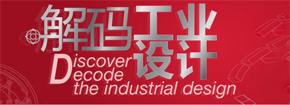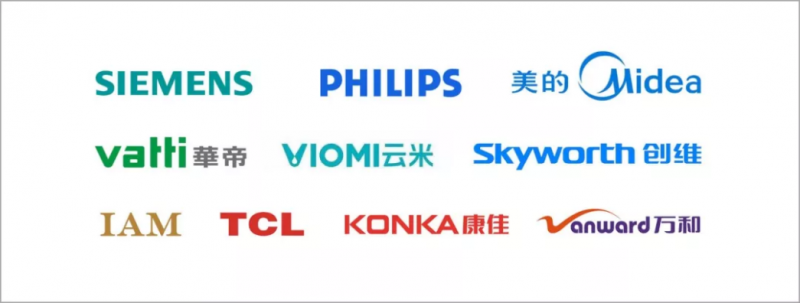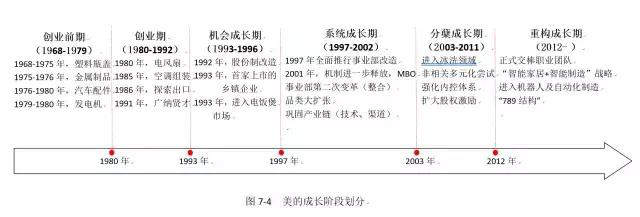Dieter Rams 迪特·拉姆斯现代设计原则
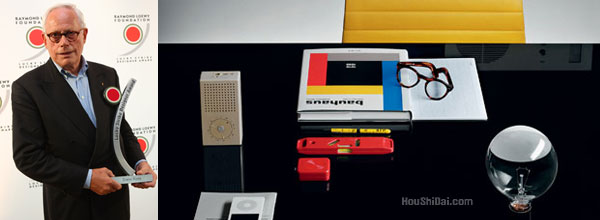
迪特·拉姆斯(Dieter Rams, 1932- ):“诗意的简约”
拉姆斯早年在德国威斯巴登的实用艺术学校学习建筑设计及室内设计,后作为职业工业设计师从事设计活动。20世纪50年代中期,拉姆斯等一批年轻设计师受聘于当时尚默默无闻的博朗公司,组建设计部,并与乌尔姆造型学院建立了合作关系。该院的产品设计系主任古戈洛特发展出一套系统设计的方法,而拉姆斯则成为该理论的积极实践者。1956年,拉姆斯与古戈洛特共同设计了一种收音机和唱机的组合装置,该产品有一个全封闭的白色金属外壳,加上一个有机玻璃的盖子,被称为”白色公主之匣”。1959年,他们将系统设计理论应用到实践中,设计了袖珍型电唱机与收音机组合,与先前的音响组合不同的是,其电唱机和收音机是可分可合的标准部件,使用十分方便,这种积木式的设计是以后高保真音响设备设计的开端,到了70年代,几乎所有的公司都采用这种积木式的组合体系。
拉姆斯将系统设计方法在实践中逐渐完善,并推广到家具乃至建筑设计,使整个空间有条不紊,严格单纯,成为德国的设计特征之一。
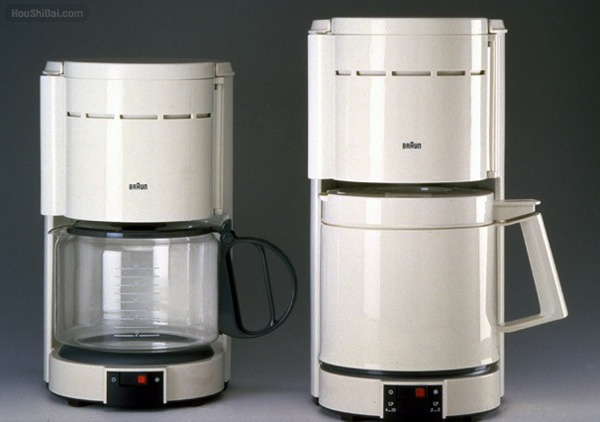
系统设计形成的完全没有装饰的形式特征,被称为”减约风格”,色彩上主张采取中性色彩:黑,白,灰。拉姆斯认为单纯的风格只不过是解决系统问题的结果,提供最大的效率并”清除社会的混乱”,他说:最好的设计是最少的设计,因此被设计理论界成为”新功能主义者”。
德国设计大师,被认为是功能主义最重要的代表人物之一。从1955年到1997年,他与Braun保持了长期的合作关系,担任了所有和产品开发有关的职务:建筑师、室内设计师、产品设计师、设计室主任、设计总监、常务董事。可以说,他的设计与Braun密不可分。他设计的产品多种多样,从闹钟到粉碎器,都带有鲜明而独特的个人风格。他获得过许多奖项,其作品曾在世界最重要的画廊展出。他被看作是率先采用生态友好技术的先锋之一,他将这种技术使用在日用小家电的设计中。他的作品在细节上一丝不苟,比如他设计的便携式收音机或收音机、CD一体机。60年代,他设计了606书架和620可调节椅子,为Vitsoe设计了钢制的601/601,该产品在80年代经De Padova公司把材料改成铝之后重新推出。他深信产品应该优先考虑功能,而不是外形。在他的设计中,他始终表现出对物品使用方式的尊重。
迪特·拉姆斯十定律
世界各地的许多年青设计师下个月的工作日程上都会出现一个相同的内容:参加博朗设计大赛。从1968年开始,博朗公司每两年都要举办一次设计大赛,鼓励参与者选题自由,并完全独立于博朗公司的产品计划,许多年轻设计师或者学设计的学生都视这个比赛为人生跳板。40年过去了,每届的参赛作品数量不断增长,参赛者也遍及世界各地50个国家,博朗设计奖已经由当时地区性奖项变为了国际知名的设计大奖,唯一不变的是它的评奖标准——迪特·拉姆斯的十条设计定律。
拿掉诗意的东西
“迪特·拉姆斯”字面上给人的印象只是一个很普通的名字——尽管人们并没有意识到上世纪50年代开始,家用电器开始进入大众生活,其中很多经典就是出自他手。他带领他的设计团队把品质优秀设计精良的产品带入千家万户。从剃须刀到录放机;计算器到闹钟;腕表到收音机,拉姆斯为德国著名家用电器厂商博朗设计的这些产品凭借超群的品质和优雅的功能成为家用电器的标杆,其他现代家用电器可以说都是向这个标准看齐的。
这位已经75岁的设计师一生致力于设计开发好用的产品。这些产品非常实用,而且细节经过周密考虑。同样重要的是他对简约的执着追求。每件产品,无论是一把牙刷还是HI-FI音响,他都力求去除不相关的元素,而保留属于事物最本质的东西。正像他说的“拿掉诗意的东西”。
他带给我们的是一种清新的工业美学:工业标准件经过精巧的组合,装在铝合金和新型塑料的外壳中;清晰易懂的图标加上友好的使用界面;中性且低调的色彩处理就算是今天也很容易跟我们的居室环境配合。
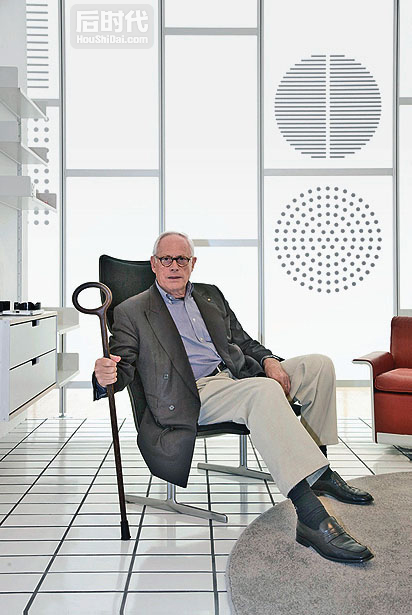
“拉姆斯式”产品
迪特·拉姆斯1932年出生于德国威斯巴登。改学建筑之前他在这里学了木匠。1953年毕业之后,拉姆斯在一家叫Otto Apel’s 的建筑事务所工作。在这之后的1955年他才受聘于博朗。拉姆斯说他进博朗完全是机缘巧合。但是他确实是在正确的时间去了正确的地方。
对于拉姆斯而言,加入博朗更像是加入一个由几个志趣相投的年轻人组织的团队。加入博朗不久,拉姆斯就成为了公司计划的核心,年轻的老板Erwin和Artur Braun非常信任他。在先锋设计师Wilhelm Wagenfeld(包豪斯),Fritz Eichler 和Hans Gugelot(乌尔姆学院)的影响下,他们彻底重组了这个在1921年由父辈创立的公司。
接下来整整一年时间,拉姆斯一直跟Hans Gugelot合作设计一款新型的收录机。这就是著名的Phonosuper SK4。这台收录机因为有着透明顶盖和白色的金属外壳,而被称作“雪白的匣子”。SK4具有革命性的创新设计。她跟当时任何家用电器都不一样——不仅仅因为敦实的比例——而是因为布尔乔亚们钟爱的家用电器被如此巧妙的安放在一个像家具一样的盒子里。这在当时无疑是非常时髦的设计。SK4只是拉姆斯和博朗40年合作的开始。1961年,29岁的拉姆斯成为博朗设计部门的负责人。他带领着他的团队成员承担了几乎所有跟设计相关的事务,包括产品设计到平面设计,甚至新技术开发。而各种国际设计奖项也都纷至沓来。
拉姆斯的职业生涯中很少设计除博朗以外的产品。但是,跟Niels Vitsae的合作是个例外。这家德国家具品牌从而开发出了“拉姆斯式”的产品——远离时尚;设计精良;品质优秀;堪称经典。
1960年,拉姆斯为Vitsae设计了模块化的606家具系统。这套系统延续了一系列模块化家具的设计理念。作为一套家具系统,拉姆斯几乎尽他所能将其做到了完美。这套系统从发布开始一直生产销售至今。上世纪60年代购买这套系统的客户到现在仍然可以添加或者更换其中的组件,像书桌,茶几,书柜都可以完美搭配。
Naoto Fukasawa 和 Jasper Morrison 这两位当红的设计大师可以说都深受拉姆斯的影响。另外还有苹果的设计总监Jonathan Ive打造的iPod iBook也折射出了拉姆斯的设计哲学——“更少但是更好的设计”。为了向大师致敬,Jonathan 甚至把iPhone的计算器界面直接设计成了拉姆斯1987年设计的ET44便携式计算器的模样。2006年东京的“Super Normal”设计展上,Fucasawa 和 Morrison从推广优良设计的角度出发,展出和介绍了拉姆斯的606家具系统。拉姆斯的许多设计,比如LE1扬声器,T2台灯和T3便携收音机都被纽约MoMA博物馆永久收藏。
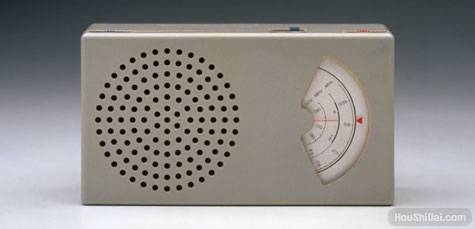
道德的设计,耐久的设计
“耐久设计”这个概念数年前就出现了。拉姆斯自始至终都坚持把这一概念贯穿到他所有的设计中去。他提倡设计要去除日益增长的所谓“视觉污染”和“肤浅的垃圾文化”。Vitsoe的总监Mark Adams也支持拉姆斯“耐久设计”的设计哲学。他也坚决反对不合理的低劣设计所带来的污染和浪费:“半个世纪以来,我们越来越认识到:我们必须认识到用少而耐久的物品可以过更理想的生活。”
优秀的设计一定是道德的设计,优秀的设计也一定是耐久的设计,然而优秀的设计也需要好的策略来支持。拉姆斯认为:只有具备以下条件才能通过设计创造出品质优秀的产品——跟制造商和用户保持良好的沟通与合作;设计能被大多数的民众所接受和理解。“产品文化的危机迫使我们不得不接受新的设计价值观:设计的价值必须由其在市场的表现来评价。”
建立起20世纪工业设计标准的拉姆斯本该急流勇退安享晚年,但是他现在仍然在为他的理想而忙碌。拉姆斯在Kronberg的家里几乎所有的东西都是自己亲自设计的。他解释道:“我只能跟我自己设计的东西一起生活。”现在拉姆斯很少在家里工作,而是一直奔波于世界各地办展览,向公众展示他的设计和理念。最近在莫斯科的Kuskovo Palace博物馆就有他的个人作品展。拉姆斯非常喜欢日本传统美学。其中Wabi-Sabi跟他自己的理想——“诗意的简约”非常接近。他自己的花园采用日本式的线条;而且他称2005年在日本Kyoto的Kenninji Zen 个展是他“个人职业生涯的闪光点”。
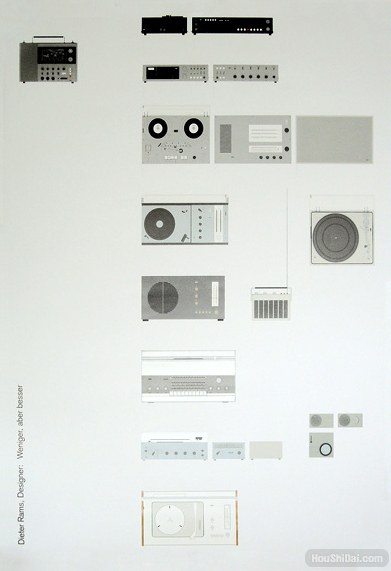
拉姆斯十大设计定律:
1. 好设计是创新的 Good Design is innovative
It does not copy existing product forms, nor does it produce any kind of novelty for the sake of it. The essence of innovation must be clearly seen in all functions of a product. The possibilities in this respect are by no means exhausted. Technological development keeps offering new chances for innovative solutions.
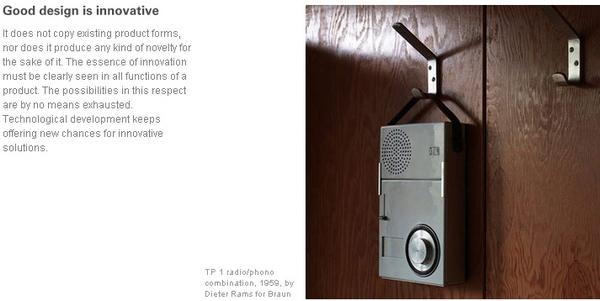
2. 好设计让产品有用 Good Design makes a product useful
非可用勿扰
A product is bought in order to be used. It must serve a defined purpose – in both primary and additional functions. The most important task of design is to optimise the utility of a product.
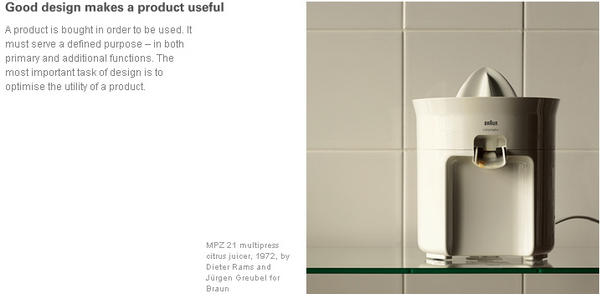
3. 好设计有美感 Good Design is aesthetic
美感很重要,懂得审美也很重要
The aesthetic quality of a product – and the fascination it inspires – is an integral part of the its utility. Without doubt, it is uncomfortable and tiring to have to put up with products that are confusing, that get on your nerves, that you are unable to relate to. However, it has always been a hard task to argue about aesthetic quality, for two reasons.
Firstly, it is difficult to talk about anything visual, since words have a different meaning for different people.
Secondly, aesthetic quality deals with details, subtle shades, harmony and the equilibrium of a whole variety of visual elements. A good eye is required, schooled by years and years of experience, in order to be able to draw the right conclusion.
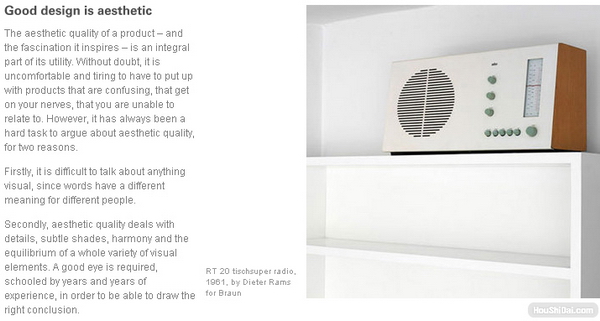
4. 好设计有助于产品的传达 Good Design helps a product be understood
让产品会说话
It clarifies the structure of the product. Better still, it can make the product talk. At best, it is self-explanatory and saves you the long, tedious perusal of the operating manual.
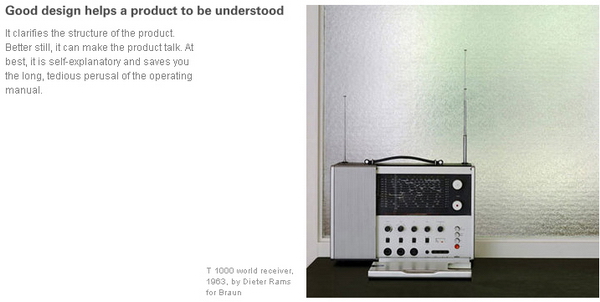
5. 好设计无障 Good Design is unobtrusive
留点空间给用户
Products that satisfy this criterion are tools. They are neither decorative objects nor works of art. Their design should therefore be both neutral and restrained leaving room for the user’s self-expression.
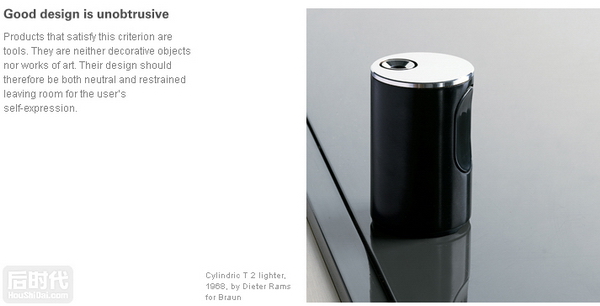
6. 好设计是诚实的 Good Design is honest
吹嘘,越吹越虚
An honestly-designed product must not claim features it does not have – being more innovative, more efficient, of higher value. It must not influence or manipulate buyers and users.
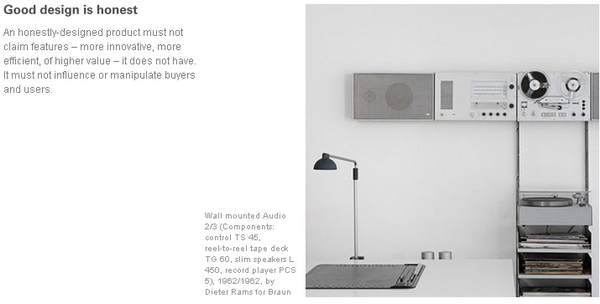
7. 好设计是持久的 Good Design is durable
美感很重要,懂得审美也很重要
It is nothing trendy that might be out-of-date tomorrow. This is one of the major differences between well-designed products and trivial objects for a waste-producing society. Waste must no longer be tolerated.
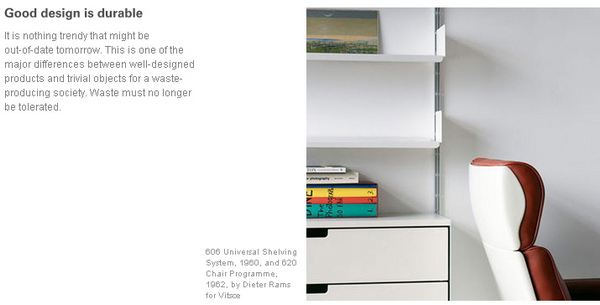
8. 好设计追求细节 Good Design is thorough to the last detail
Thoroughness and accuracy of design are synonymous with the product and its functions, as seen through the eyes of the user
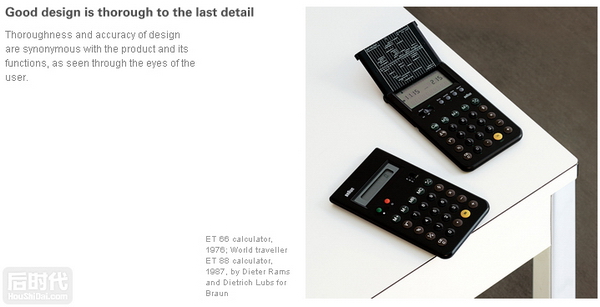
9. 好设计关注环境 Good Design is concerned with environment
拒绝垃圾,实体或像素的
Design must contribute towards a stable environment and a sensible use of raw materials. This means considering not only actual pollution, but also the visual pollution and destruction of our environment.
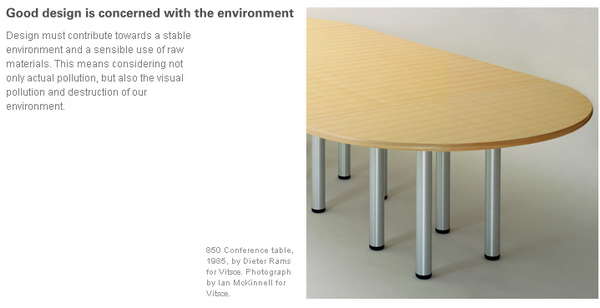
10. 好设计是极简的 Good Design is as little design as possible
Back to purity, back to simplicity.
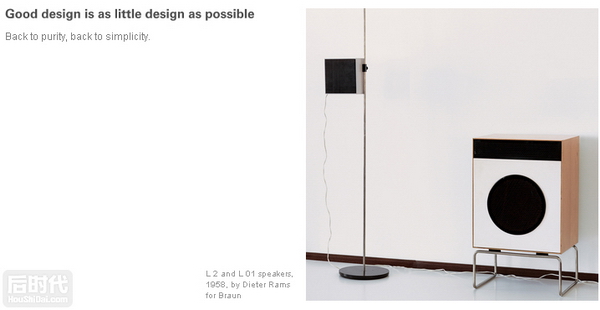
德国工业设计大师 Dieter Rams 的十条优秀设计准则
【1、优秀的设计应该是创新的。Good design is innovative.】
创新的可能性是永远存在并且不会消耗殆尽的。科技日新月异的发展不断为创新设计提供了崭新的机会。同时创新设计总是伴随着科技的进步而向前发展,永远不会完结。
It does not copy existing product forms, nor does it produce any kind of novelty for the sake of it. The essence of innovation must be clearly seen in all functions of a product. The possibilities in this respect are by no means exhausted. Technological development keeps offering new chances for innovative solutions.
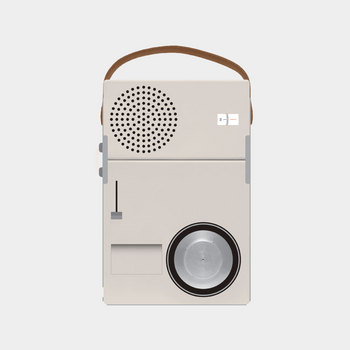
(TP 1 收音机/唱机组合, 1959,Dieter Rams为博朗公司设计)
【2、优秀的设计让产品更加实用。 Good Design makes a product useful.】
产品买来是要使用的。 至少要满足某些基本标准,,不但是功能,也要体现在用户的购买心里和产品的审美上。优秀的设计强调实用性的同时也不能忽略其它方面,不然产品就会大打折扣。
A product is bought in order to be used. It must serve a defined purpose – in both primary and additional functions. The most important task of design is to optimise the utility of a product.
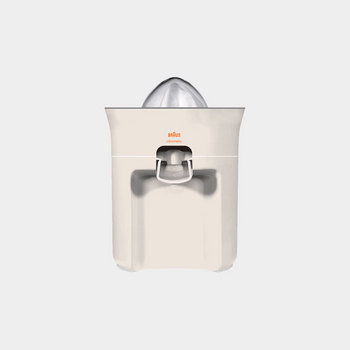
(MPZ 21 multipress榨汁机, 1972,Dieter Rams and Jürgen Greubel为博朗公司设计)
【3、优秀的设计是美的。Good Design is aesthetic.】
产品的美感是实用性不可或缺的一部分,因为每天使用的产品都无时无刻的影响着人类和我们的生活。但是只有精湛的东西才可能是美的。
The aesthetic quality of a product – and the fascination it inspires – is an integral part of the its utility. Without doubt, it is uncomfortable and tiring to have to put up with products that are confusing, that get on your nerves, that you are unable to relate to. However, it has always been a hard task to argue about aesthetic quality, for two reasons.
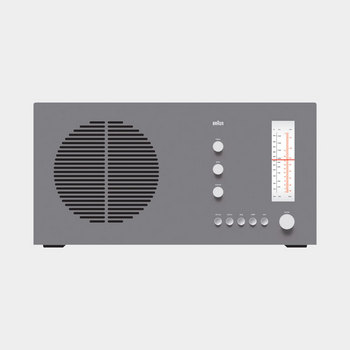
(RT 20 tischsuper收音机, 1961,Dieter Rams为博朗公司设计)
【4、优秀的设计使产品更容易被读懂。 Good Design helps a product be understood.】优秀的设计让产品的结构清晰明了。更强大的是它能让产品自己说话。最好是一切能够不解自明。
It clarifies the structure of the product. Better still, it can make the product talk. At best, it is self-explanatory and saves you the long, tedious perusal of the operating manual.
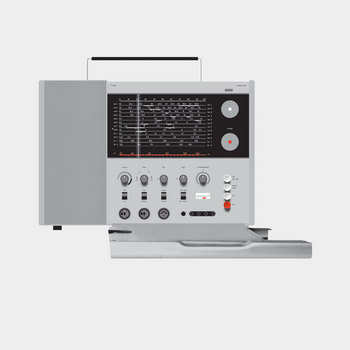
(T 1000 收音机, 1963, Dieter Rams为博朗公司设计)
【5、优秀的设计是毫无妨碍的。Good Design is unobtrusive.】
产品要像工具一样能够达成某种目的。 它们既不是装饰物也不是艺术品。因此它们应该是中庸的,带有约束的,这样会给使用者的个性表现上留有一定空间。
Products that satisfy this criterion are tools. They are neither decorative objects nor works of art. Their design should therefore be both neutral and restrained leaving room for the user’s self-expression.

(圆柱形T2打火机, 1968,Dieter Rams为博朗公司设计)
【6、优秀的设计是诚实的。Good Design is honest.】
不要夸张产品本身的创意,功能的强大和其价值。也不要试图用实现不了的承诺去欺骗消费者。
An honestly-designed product must not claim features it does not have – being more innovative, more efficient, of higher value. It must not influence or manipulate buyers and users.
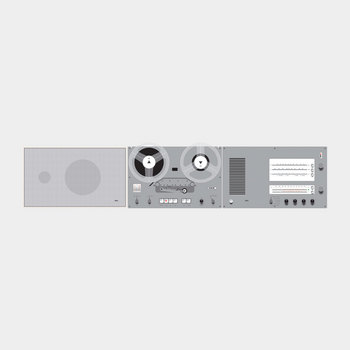
(L 450 平板扬声器,TG 60开盘式录音机和TS 45控制器, 1962-64,Dieter Rams为博朗公司设计)
【7、优秀的设计经得起岁月的考验。Good Design is durable.】
它使产品避免成为短暂时尚反而看上去永远都不会过时。和时尚设计不同的是,它会被人们接受并使用很多年,甚至是在当今被一次性商品充斥的社会。
It is nothing trendy that might be out-of-date tomorrow. This is one of the major differences between well-designed products and trivial objects for a waste-producing society. Waste must no longer be tolerated.
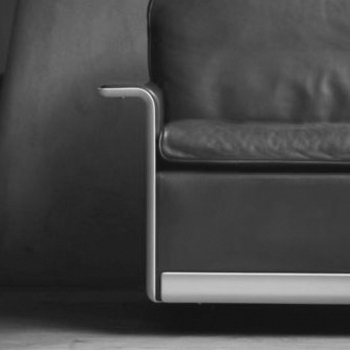
(620椅子, 1962,Dieter Rams for为Vitsoe公司设计)
【8、优秀的设计是考虑周到并且不放过每个细节的。 Good Design is thorough to the last detail.】
任何细节都不能敷衍了事或者怀有侥幸心理。设计过程中的悉心和精确是对消费者的一种尊敬。
Thoroughness and accuracy of design are synonymous with the product and its functions, as seen through the eyes of the user.
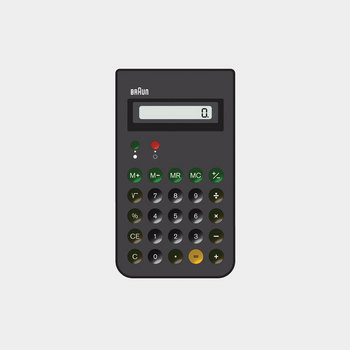
(ET 66 计算器, 1987,Dietrich Lubs为博朗公司设计。)
【9、优秀的设计是关注环境的。Good Design is concerned with environment.】设计能够对保护环境起到极大的贡献。让产品在整个生命周期内减少对资源的浪费,降低对自然的破坏并且不要产生视觉污染。
Design must contribute towards a stable environment and a sensible use of raw materials. This means considering not only actual pollution, but also the visual pollution and destruction of our environment.
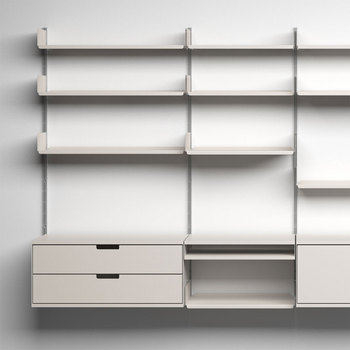
(606 通用搁架, 1960,Dieter Rams为Vitsœ公司设计)
【10、优秀的设计是简洁的。Good Design is as little design as possible.】简洁,但是要更好–因为它浓缩了产品所必须的具备因素,剔除了不必要的东西。 “大道至简,返璞归真”
Back to purity, back to simplicity.
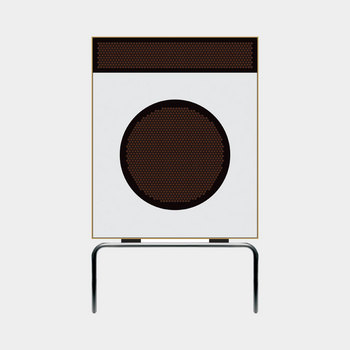
(L 2扬声器, 1958,Dieter Rams为博朗公司设计)
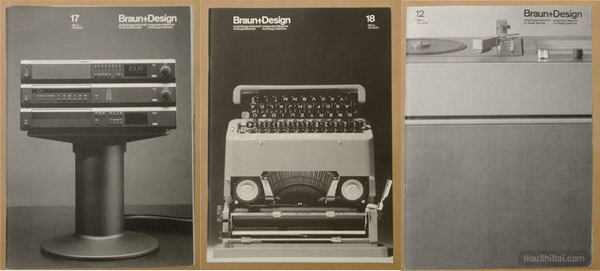
Dieter Rams作品欣赏:
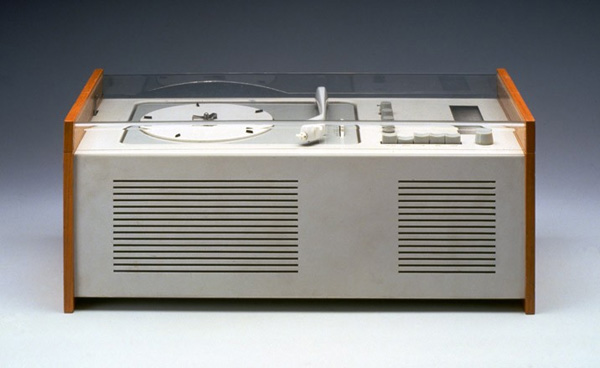
SK4 record player, 1956 Braun 被英国人戏称为“白雪公主的棺材”,以嘲讽它的极简。
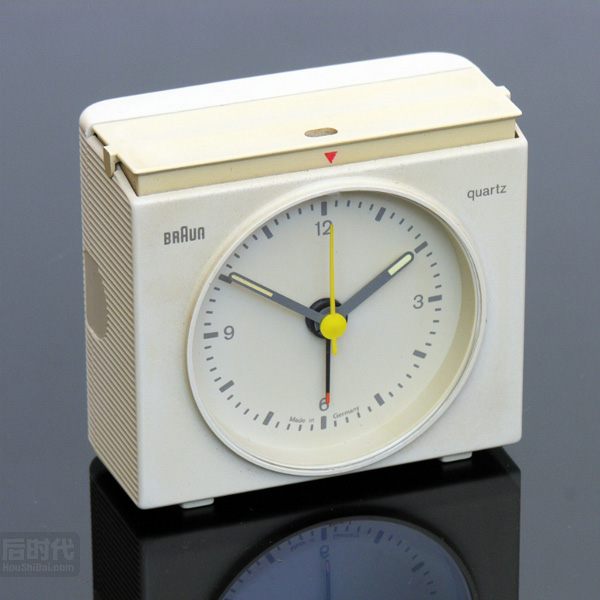
Braun Alarm Clock 博朗闹钟
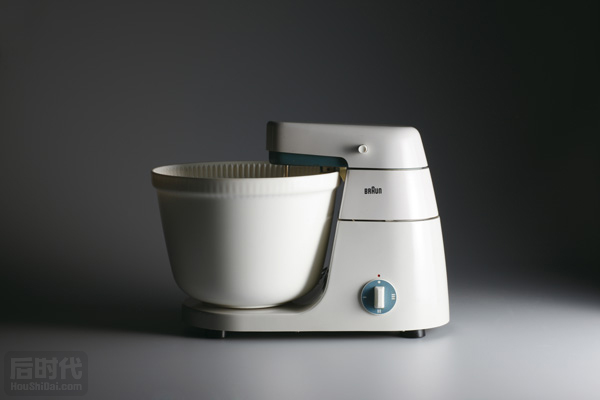
KM3 kitchen Machine 1957 ,Braun

Braun SK2
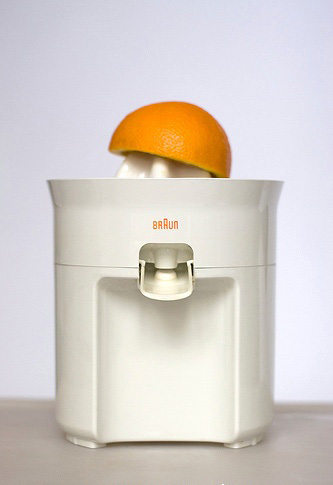
MPZ2 1972 ,Braun
Dieter Rams与苹果设计风格的延续
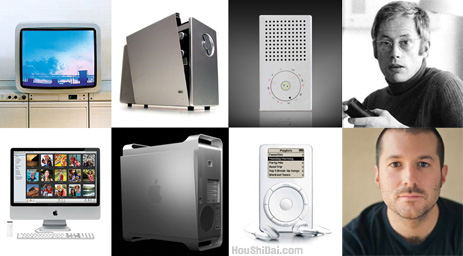
Dieter Rams是一名来自德国的工业设计大师,简约主义设计风格的代表人物、新功能主义的创始人和代言人,是建立起20世纪工业设计标准的大师级人物。Dieter Rams这位年近80岁设计大师的许多设计作品,至今还被世人沿用,男士们应该还满熟悉博朗的剃须刀,就是Rams在博朗公司重组后推出的第一个产品,即大获成功。此外还有很多现代艺术、建筑和影像的设计作品,60年代初的SK55唱片机和T1000 收音机,以及人们至今还使用着的Vitsoe 606货架系统,都是Rams的作品。
Fast Company Design最近采访了Dieter Rams,大师在采访中分享了一些对于现代通用设计的想法,优秀设计原则,以及杰出、持续的设计方案的重要性和对公司的价值。
从下面Rams电子产品的设计图中我们可以看出,苹果的设计风格其实在某些方面与Rams的设计风格十分相似,但是Rams并没有说苹果的设计团队抄袭这样的话,反而称赞 Jonathan Ive和苹果的其他设计师能够沿用他曾经使用过的设计准则,因为理念相似,所以产品风格才会有相似之处。
Dieter Rams相信,苹果这样的理念「模仿」是对他本人最真诚敬重的表现,Dieter Rams曾经和 Jonathan Ive一起参观过苹果的工作流程,并且大加称赞。同时,Dieter Rams还表示 Jonathan Ive与苹果CEO Steve Jobs好友般的关系也是让苹果优秀产品设计得以持续的原因之一。Rams回忆,他看到Ive-Jobs之间的关系,就仿佛当初他在博朗公司一样,设计师可以直接和最高执行官汇报交流,而不是通过什么市场部门。
1960s Braun Products Hold the Secrets to Apple’s Future
The year 2008 marks the 10th Anniversary of the iMac, the computer that changed everything at Apple, hailing a new design era spearheaded by design genius Jonathan Ive. What most people don’t know is that there’s another man whose products are at the heart of Ive’s design philosophy, an influence that permeates every single product at Apple, from hardware to user-interface design. That man is Dieter Rams, and his old designs for Braun during the ’50s and ’60s hold all the clues not only for past and present Apple products, but their future as well:
When you look at the Braun products by Dieter Rams—many of them at New York’s MoMA—and compare them to Ive’s work at Apple, you can clearly see the similarities in their philosophies way beyond the sparse use of color, the selection of materials and how the products are shaped around the function with no artificial design, keeping the design “honest.”
This passion for “simplicity” and “honest design” that is always declared by Ive whenever he’s interviewed or appears in a promo video, is at the core of Dieter Rams’ 10 principles for good design:
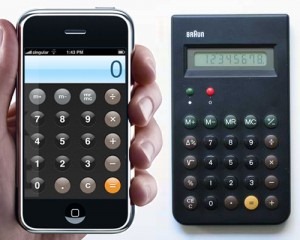
2008年是iMac问世十周年纪念,而Jonathan Ive就是设计这台扭转Apple命运,乃至创造一个新时代电脑的设计奇才。多数人可能并不知道,Ive设计哲学受到另一位设计师深刻的影响,这个影响反应在每一件Apple的产品——从硬件到用户界面。这个人就是Dieter Rams,从他在上世纪50年代到60年代为德国品牌Braun(博朗)设计的产品中,我们依稀看到Apple过去到现在设计的产品中沿袭着的“设计密码”,可以预见未来Apple的产品还将受到影响。
时至今日,当人们看到陈列在纽约现代美术馆中那些由Rams设计的Braun生产的产品,当将他们与Ive为Apple设计的产品进行对比的时候,二者之间的设计哲学——从色彩的使用,材料的选择,到“形式追随功能”,剔除人工痕迹,体现“坦诚”的设计思想——都是那么相似。 Ive在多个采访和设计讲解过程中不厌其烦地阐述他如何痴迷于“简约”的设计风格和“坦诚”的设计语言,实际上这也是对Rams提出的十条设计理念的追求:
• Good design is innovative.
• Good design makes a product useful.
• Good design is aesthetic.
• Good design helps us to understand a product.
• Good design is unobtrusive.
• Good design is honest.
• Good design is durable.
• Good design is consequent to the last detail.
• Good design is concerned with the environment.
• Good design is as little design as possible.
好的设计是创新的 Good design is innovative.
好的设计创造好用的产品 Good design makes a product useful.
好的设计是符合审美的 Good design is aesthetic.
好的设计帮助我们理解产品 Good design helps us to understand a product.
好的设计是含蓄的 Good design is unobtrusive
好的设计是坦诚的 Good design is honest.
好的设计是耐用的 Good design is durable.
好的设计由最终的细节决定 Good design is consequent to the last detail.
好的设计关注环境 Good design is concerned with the environment.
好的设计是“没有”设计 Good design is as little design as possible.
Ive’s inspiration on Rams’ design principles goes beyond the philosophy and gets straight into a direct homage to real products created decades ago. Amazing pieces of industrial design that still today remain fresh, true classics that have survived the test of time.
The similarities between products from Braun and Apple are sometimes uncanny, others more subtle, but there’s always a common root that provides the new Apple objects not only with a beautiful simplicity but also with a close familiarity.
Ive受到的启发不仅仅来自Rams的设计哲学,更直接来自Rams设计的真实产品——那些几十年前的产品。拿今天的目光看,Rams设计的工业产品还是那么新鲜——所谓经典是要经得起时间的考验,Rams的设计做到了。比较Braun的经典设计和Apple的设计,二者之间的相似性难以描述,但有时又是那么明显。可以看到,Apple的设计中所蕴含的简约之美与Braun经典产品体现的风格是一脉相承的——这点相当乃人寻味。
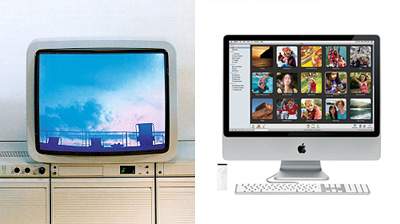
Braun Atelier TV and latest iMac 24 博朗专业级电视 & 08新款iMac
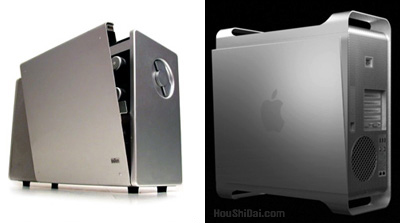
Braun T1000 radio and PowerMac G5/Mac Pro 博朗T1000型收音机 & Mac Pro(PowerPC G5)
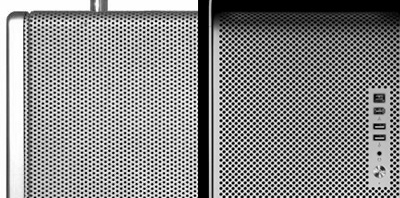
Detail of the radio perforated aluminum surface 以上两者外表的排孔铝合金材质
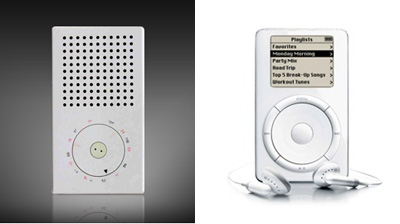
Braun T3 pocket radio and Apple iPod 博朗T3口袋收音机 & iPod 1st Generation
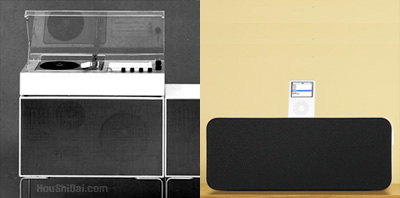
Braun L60 sound system and Apple iPod Hi-Fi 博朗L60音响系统 & iPod Hi-Fi
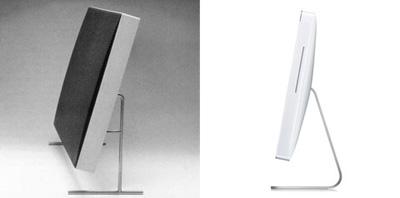
Braun LE1 speaker and Apple iMac 博朗LE1音箱 & iMac
Some people will probably call these examples a “rip-off” but, in a world where industrial design and art are constantly being recycled into new work, I just see Apple’s products as a great evolution to classic concepts. Now, as I look at Rams’ work I can’t help but to wonder: which of these old Braun designs will Apple revive next? Is there a MacBook Air—the rumored ultra-slim wire-free portable that seems to be the favorite bet for tomorrow’s keynote—in there?
Dieter Rams Gallery
Hopefully, we’ll discover at least some answers tomorrow. See you at Macworld!
有人可能会把这些例子叫做“苹果抄袭”,但在现实中工业设计乃至艺术本身本来就是不断继承变化,加工循环的。从这个角度看,Apple的产品是在经典基础上不错的演变。
不管是Ive或是Dieter Rams,他们所提倡的所谓“简单”的造型形态不是指设计风格,因为造型形态只是物理表象,达到简化造型有多重手段。从斯堪的维亚的设计中可以看到,通过近乎完美的人机效用设计、通过对材料特质的利用,造型形态的简化被作了最好的阐释。约瑟夫•艾尔伯斯教导学生通过对“材料的经济使用”来作设计,形成简单而在“视觉上和构造上的不同层次”,这种对材料与造型关系的研究,是不“粉饰”设计、求简约精致的精要。
丹麦工业设计师Jacob Jensen相信“设计是一种语言,它能够被任何人理解”。
上一条新闻:软化了的“气泡玻璃鱼缸”
下一条新闻:inch MID平板电脑
更多关于Dieter Rams 迪特·拉姆斯现代设计原则 的新闻
- 回形别针的巧妙设计2012-07-27
- 个人骑行助理设计,不用掏出手机...2019-06-19
- 使时间变成“千纸鹤” -Calendar Clock’22021-07-30
- 工业设计——漂泊在宁静之中2013-03-18
- 李立成作品选2009-12-19
最新文章
- Flum时来运转-加湿器设计2022-11-07
- 农产品手提袋2022-11-01
- 手绘欣赏2022-10-31
- Pony Number 32022-10-11
- Fantasma2022-10-09





